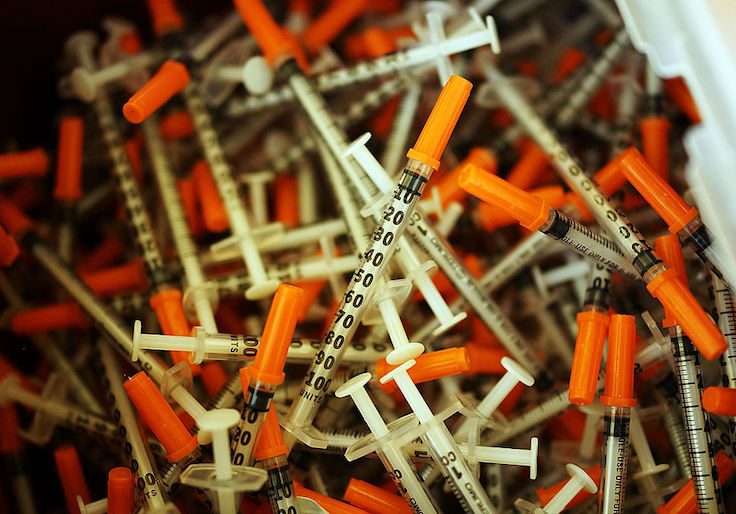Syringe exchange programs, a popular method for reducing infections associated with injection drug use, might also lead to more drug overdose deaths, a study released Monday argues.
The study, authored by Vanderbilt economist Analisa Packham, gathers together nationwide, county-level data on syringe exchange programs (SEP), HIV infection rates, drug overdose deaths, and other comorbidities of drug use. In her analysis, Packham finds that a county gaining an SEP reduces HIV diagnosis rates by around 12 percent, but also raises drug-related mortality rates by roughly the same amount.
SEPs, also referred to as "needle exchanges," are a hallmark of modern drug-harm-reduction policy. They provide injection drug users with clean needles and other paraphernalia so as to discourage the sharing of needles and, thereby, diseases.
SEPs are widespread, permitted under the law in 26 states and the District of Columbia. More than 200 exchanges operate nationwide, with 86 opening between 2009 and 2016. This recent expansion is partly prompted by the fact that as drug overdose rates have risen, so too have rates of needle-transmitted diseases, like Hepatitis C and HIV. Federal data indicate that injection drug use is associated with approximately 3,500 new cases of HIV every year.
Much of the prior research on SEPs, Packham notes, was done during the AIDS crisis of the 1980s and 1990s, and consistently associated the programs with lower rates of HIV infection and death. The new paper adds data on the modern context, both regarding how SEPs affect infection and how they affect drug use more generally.
To conduct her analysis, Packham used a "difference-in-differences" approach to compare counties that introduced an SEP between 2009 and 2016 and those that did not. She successfully replicated the finding that counties with SEPs saw lower rates of HIV diagnosis. Specifically, she estimates that an SEP lowers HIV infection rates by 12.7 percent, but that figure declines—and is not statistically significant—after the introduction of controls for state-level economic and demographic factors.
This decline is swamped by the effect that SEPs have on drug overdose deaths. Counties with SEPs saw an 11.6 percent increase in drug deaths compared to those without, and a 25.4 percent increase in specifically opioid-involved deaths. These effects remain significant and large when controls are introduced.
"These effects correspond to nearly 2.5 additional fentanyl-related deaths per county over the 0-7 years following a SEP opening," Packham writes, "providing support for two stark conclusions: (i) SEPs lead to greater risk of opioid misuse and overdose and/or (ii) the increase in mortality rate among injection drug users simultaneously reduces the probability that these users will spread HIV through needle sharing in the future."
Packham corroborates her finding by analyzing rates of drug-involved ER visits, in-patient stays for drug-related complications, and drug arrests. The former two increase with the introduction of an SEP; the latter initially increases, but is unchanged after about two years.
Packham speculates three underlying causes might be at play. It could be that a program offering free drug paraphernalia lowers the time and money cost of using drugs, thus encouraging use. SEPs also offer a place for users to "network," which could lead to more drug connections being made. Lastly, SEPs may give drug users a place to cluster and use without fear of legal blowback, leading to more use and therefore more harm.
"Policymakers and the public health community more broadly should be careful to consider all costs and benefits of SEPs, including long-run effects generated by lowering the costs of consuming injection drugs," Packham writes. "In the wake of increased drug-related deaths and state policies to curb this epidemic, my estimates shed new light on how local policies can affect syringe sharing, drug overdose, and drug-related crime."
Packham is not the first economist to find that a popular harm-reduction policy paradoxically increases drug deaths. A 2018 paper by economists Jennifer Doleac and Anita Mukherjee attracted outcry when it argued that distributing the overdose-reversing drug naloxone (Narcan) could lead to more overdoses. Packham notes in her study that another, earlier paper, on the other hand, links naloxone-access laws to lower OD death rates.
Perhaps the most important takeaway from the new paper, though, is that it adds to the empirical literature showing how complicated drug-control policy can be. Another recent paper, for example, offered a similarly paradoxical finding: Placing a limit on the length of legitimate opioid prescriptions can actually lead to patients being prescribed more opioids, not fewer. This sort of unintended consequence is a hallmark of all policy; Packham's paper makes clear that even widely accepted interventions are hardly immune.
